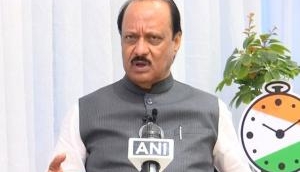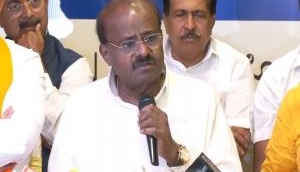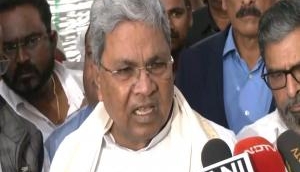
On 9 April, Delhi Chief Minister Arvind Kejriwal held a press conference to announce the details of the second round of the Odd-Even formula for vehicular traffic in the National Capital.
While the press conference was disrupted by a member of the Aam Aadmi Sena flinging a shoe at the Delhi Chief Minister, here's a quick look at what the Odd-Even scheme will include this time around:
- The Odd-Even rule will be implemented between 8am to 8pm from Monday to Saturday. The scheme will not be imposed on Sunday.
- Cars from other stays will also have to comply with the rule.
- The fine for violation will remain Rs 2000.
Transport and Rural Development Minister of Delhi, Gopal Rai announced that 5000 civil defense volunteers and 3000 from the police force, 400 ex-armymen and 120 mobile enforcement teams will dedicate their time from 8am to 8pm to help enforce and implement the scheme.
Public Transport
The number of metro trips will be increased by 252 - bringing the total up to to 3248 a day. Rai also announced that 30 extra coaches have been added.
6,000 public transport buses will ply during the scheme.
Exemptions
Here's a list of the vehicles that are exempted from the rule:
- CNG cars
- Vehicles driven by women
- Vehicles of VIPs - including the President, Prime Minister, Governors of states, Chief Justice, speaker of Lok Sabha
- Emergency vehicles
- Two-wheelers
Kejriwal and his Cabinet crew will come under the ambit of the scheme.
The government may consider exempting senior citizens, following extensive public demand. Most experts agree with this tweak to the scheme.
What has however caused considerable deliberation is the exemption of cars driven by women or men who are accompanied by children in uniforms. There is no clarity on the rules on these cars for when the children have been dropped off to school.
To add to confusion, Kejriwal said that women must step up to pick the child up from school. “In case where a male driver has to go and pick up the child, we suggest he carpool with others,” he said.
Environmental Monitoring Scheme
To monitor pollution levels, 70 monitoring centers will be set-up and additional monitoring centers will be set-up in neighboring cities bordering Delhi. The monitoring centers will primarily monitor fine dust particles.
The Delhi government will also initiate manual monitoring through hand-held light scattering system across the city.
Reactions
With respect to women being exempted, many argue that since the scheme ends at 8 pm, it is safe and convenient for women to follow the rule. Those who are involved with woman’s rights state it is important to create conditions where women not just are, but feel, safe.
“It is imperative that women use public transport for a scheme of such proportion to work. Albeit, for women to be depend on such mode of transport last mile connectivity is important. The focus should be on buses. The present fleet of buses does not meet the demand of those who depend on it,” says Kavita Krishnan, women's activist and AIWA Secretary.
Former member secretary of the Central Pollution Control Board Dr B Sengupta says while believe it is a good idea to exempt women, due to public transport being unreliable and unsafe, two-wheelers should not have been exempted as they contribute heavily to pollution.
Kejriwal said two-wheelers could not be brought under the rule since around 40 lakh people used them.
Does the Odd-Even formula help curb pollution?
As per an independent study conducted by researchers at Transportation Research and Injury Prevention Programme at the Indian Institute of Delhi (IIT-D), on the odd even policy at four prime locations, while the compliance rate is high, the scheme overall does not affect pollution levels.
The study called "Evaluation of the effects of the 15-day odd-even scheme in Delhi: A preliminary report", states the air pollution benefits were not apparent because of various factors and that the data obtained Delhi Pollution Control Committee (DPCC), which shows decrease in pollution levels, was not enough to analyse the benefits of the intervention.
As per the Delhi Pollution Control Committee, on the first day of implementation, PM2.5 fell in the first half of the day, but increased in the evening.
Data did show that vehicular pollution was a substantial contributor to PM2.5 levels, since the levels increased after 8pm, when the restrictions on the movement of vehicles were lifted.
Dinesh Mohan, a former IIT professor and one of the authors in the study says “there is no pragmatic reason for the scheme to be implemented again. It is causing inconvenience without any benefits. The study clearly shows there is absolutely no impact on pollution levels.”
Dinesh also argues that tweaking the scheme, like decreasing exemptions, will not work. “It did not work elsewhere in the world with respect to pollution levels, why would it work in India?”
The IIT report concludes, “The combined PM2.5 emissions of buses, three wheelers and motorised two-wheelers is estimated to be 20% of the transport sector compared to cars that contribute an estimated 16%. In light of the fact increase in flow of buses, three wheelers and motorised two wheelers seems to be of a similar magnitude as the decrease in car flow, the effect of decrease in PM2.5 emissions by cars would be even less. It is possible that the decrease in emissions from cars may be offset by an increase in flow of other vehicles.”







![BJP's Kapil Mishra recreates Shankar Mahadevan’s ‘Breathless’ song to highlight Delhi pollution [WATCH] BJP's Kapil Mishra recreates Shankar Mahadevan’s ‘Breathless’ song to highlight Delhi pollution [WATCH]](https://images.catchnews.com/upload/2022/11/03/kapil-mishra_240884_300x172.png)

![Anupam Kher shares pictures of his toned body on 67th birthday [MUST SEE] Anupam Kher shares pictures of his toned body on 67th birthday [MUST SEE]](https://images.catchnews.com/upload/2022/03/07/Anupam_kher_231145_300x172.jpg)






